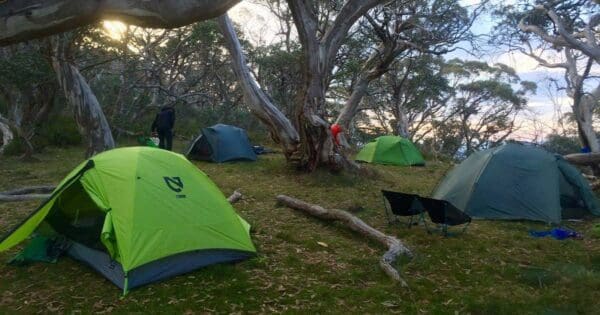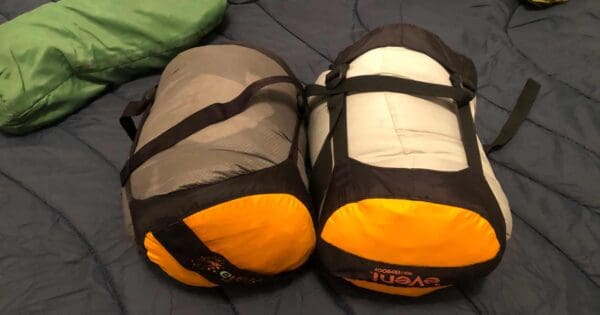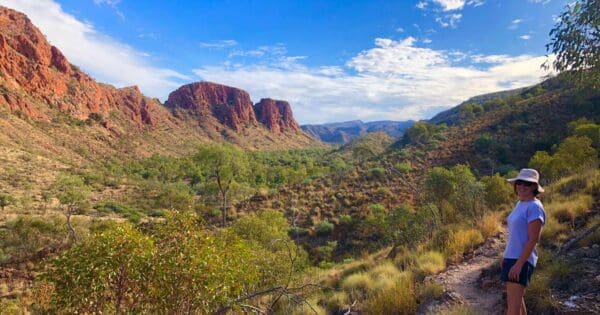We experienced nature in a way we never have, nor do we want to again
While enjoying a great day hike near Daylesford in Victoria my wife and I spotted an emu in the valley below. Always enjoying seeing our amazing wildlife, we stood on the edge of the trail for a few minutes watching in awe it as it wandered along the river flats below. Seemingly indifferent to our presence, it looked up then started making its way up the ridge line towards us.
We were excited it was coming closer but thought it was unusual behavior. Generally emus will run for cover when they see people. Not this one. It kept strutting closer and closer even though we were clearly both standing there. I was eagerly reaching for my phone so I could grab a couple of close-up pics when it stared at us and started making threatening thumping sounds. It was not pleased we were there.
We thought, this can’t be good, so started to slowly and quietly back away. We’d literally taken a few steps before it took off after us. We turned and ran.
The trail was narrow with steep embankments on both sides so we had nowhere to go but along the trail. There was nothing to hide behind so all we could do was run. As we frantically scrambled to stay on our feet, all I could hear was ‘thud, thud, thud‘ and the ever increasing thumping sounds behind us. The emu was clearly faster than us so, the only thing I could think to do was reach for a hefty stick. I grabbed the first one I saw and turned to face our pursuer.
I was shocked to see the emu was literally a metre away, towering above me with its feathers puffed and head held high. Not knowing what to do or where to go, I defensively held my stick in front of me, waving it around. Sadly my selection of a physical barrier was poor and it broke into a thousand pieces in my hand.
With nowhere to go, nowhere to hide, and nothing between us, I turned and ran again, frantically scanning the trail ahead for a better quality branch. Spotting one in front of me, I swept it off the trail as I ran, then turned to face the emu again. This time I raised my arms and started yelling as loud as I could.
The emu stopped in its tracks but was clearly not my friend. Raising my voice, I fearfully took a few steps towards it. To my relief, the emu turned and ran, striding effortlessly up the embankment next to us. Unfortunately the emu was not done with us and continued to follow us from higher ground as we walked quickly along the trail. After what seemed like an eternity (probably 5 minutes), the emu turned to retrace it steps. We were no longer being pursued.
I assumed we must have exited its territory and were no longer a threat. Needless to say, surprised, shaken but also intrigued by this encounter, our return hike turned into an extended circuit as there was no way we were going back that way again. Scary stuff.
For the rest of the hike, I kept asking myself if the way I reacted was the right way to react. Could I have done things differently? Did my actions cause harm to the emu? It is important to point out that while I picked up a stick to defend myself, I had no intention of hurting the emu. I only wanted to put something between us. Before I could know if what I had done was the best thing I could do, I had to do a bit of research about emus and their behaviour.
What is an emu?

In case you have never seen an emu, here a quick overview. Emus are a species of flightless bird existing since prehistoric times. The Emu is Australia’s tallest native bird, reaching between 1.6 m and 1.9 m when standing erect. Adult Emus are covered with shaggy grey-brown feathers except for the neck and head, which are largely naked and bluish-black. The wings are greatly reduced, but the legs are long and powerful. Each foot has three forward-facing toes and no hind toe. Most people see Emus along roadsides, near fences or other barriers, giving the impression of close association. However, Emus are not really social, except for young birds, which stay with their father. The Emu is found only in Australia. It lives throughout most of the continent, ranging from coastal regions to high in the Snowy Mountains. Emus were once found in Tasmania, but were exterminated soon after Europeans arrived. Two dwarf species of emus that lived on Kangaroo Island and King Island also became extinct.
Are emus aggressive?
While emus are typically not deemed hazardous to humans, there is a possibility of harm if they perceive a threat or are safeguarding their offspring. Generally speaking, emus are timid creatures that strive to evade human interaction. However, in self-defense, they have been known to employ their robust legs and razor-sharp talons to deliver kicks and scratches.
Similar to many other animals, emus can exhibit aggression when their offspring are at risk. Male emus, in particular, demonstrate fierce protective instincts towards their chicks, defending them against perceived threats or potential predators, including humans. In instances of aggression, emus assume an upright posture and inflate their feathers around the neck area, aiming to appear more imposing. Furthermore, hissing sounds emitted by an emu can serve as an indicator of potential danger and should be noted as a warning sign. This is exactly what happened to us.
What makes emus dangerous?

The imposing size of emus is the primary factor contributing to their potential danger. Reaching heights of up to 1.9 m, emus hold the distinction of being the second-largest bird worldwide, surpassed only by their relatives, the ostriches. This substantial stature grants emus some of the most robust legs in the animal kingdom, capable of serving as formidable weapons. A forceful kick from their legs, equipped with razor-sharp three-toed claws, possesses the capacity to inflict significant harm upon any living being, even in spite of their typically gentle disposition. Adding to their potential threat, emus exhibit remarkable swiftness, sprinting at speeds of up to 50 kilometres per hour. This agility allows them to rapidly close the gap between themselves and perceived threats.
Picture us running along a narrow track with this imposing and formidable creature bearing down on us at this pace.
Contrary to popular belief, emus are often misunderstood as aggressive and hostile towards humans, when in reality, they possess a generally calm and gentle nature. Unless provoked, emus are unlikely to engage in attacks against humans. To remain safe, it is essential to treat these majestic birds with respect and exercise caution when in their presence. By doing so, you can peacefully coexist with emus without provoking any aggressive responses. It is worth nothing that at no time did we verbally or physically provoke the emu until we were pursued, simply being in his territory was enough to provoke it to give chase.
Did we do the right thing?
Well, as it turns out, emus are highly sensitive to sudden movements and loud noises. This means that if you were to run towards an emu or make a loud banging sound near them, they are likely to become startled and take off running. In addition, emus are known to be wary of unfamiliar people and animals, so if you encounter one in the wild, it’s best to give them plenty of space and approach them slowly and calmly.
To minimise any potential issues, it is advisable to grant emus ample space and refrain from approaching them, particularly during their breeding season. This prudent approach serves as the most effective means of preventing possible complications.
knowing how to safely interact with an emu when encountering one face-to-face becomes crucial. Understanding the optimal approach is essential before approaching them too closely. The key lies in establishing a sense of safety for the emu, minimising the perception of threat. Websites I looked at suggested that kneeling down serves as an effective strategy, as it diminishes your threatening presence. I should note, there was no way I was doing this with an emu a metre from me. According to the research, if the emu shows signs of disinterest or attempts to move away, it is vital not to pursue or follow the bird. Doing so could trigger a sense of threat, potentially leading to an aggressive response involving their powerful legs. By attentively observing their behaviour and respecting their personal space, you can safely appreciate the captivating nature of these creatures from a suitable distance.
So, I think given the circumstances, I am happy we did the right thing. I probably didn’t need to pick up a stick as waving my warms and raising my voice could have been enough. It just felt good to have some form of barrier between us rather than my arm. If there had have been a rock or large tree to hide behind, that may have been a better approach.
Final word

Emus may seem like gentle creatures, and for the most part, they are. These birds have a naturally calm disposition and don’t pose any real threat to humans. But like any animal, emus have a defense mechanism, and they will use it if they feel threatened. This can lead to aggressive behaviour, which may be dangerous if you happen to be close by. So, if you want to stay safe around these unique creatures, it’s important to avoid any actions that could provoke them. Don’t get too close to them, touch them, corner them, or do anything that would make them feel you are e threat to their chicks.
Consequently, knowing how to safely interact with an emu when encountering one face-to-face becomes crucial. It’s best to move away slowly and quietly but if you are noticed with an emu in pursuit, find a large rock or tree to hide behind and kneel down to diminish your threatening presence. If this is not possible the best thing you can do is hold your ground. Stand up tall, hold your arm high and yell as loudly as you can. If the emu turns and departs, crouch down and wait patiently until it’s gone from sight, then slowly and quietly continue on your way. If the emu doesn’t depart, all I can do is wish you luck.
By attentively observing an emus behaviour and respecting their personal space, you can safely appreciate the captivating nature of these creatures from a suitable distance.
References:
https://australian.museum/learn/animals/birds/emu/
https://www.britannica.com/list/6-of-the-worlds-most-dangerous-birds
https://nationalzoo.si.edu/animals/emu





